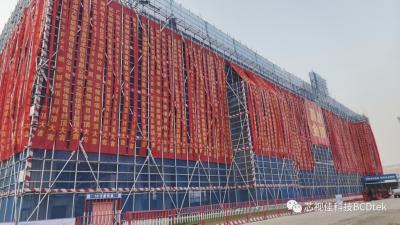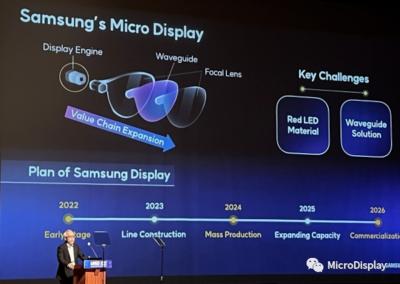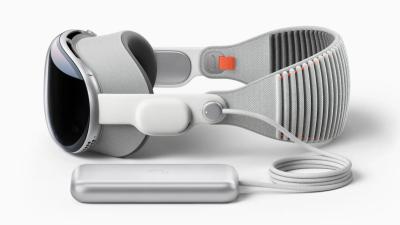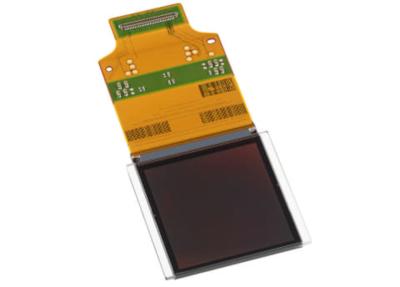OLED is a next-generation display technology that is replacing LCD displays in several markets, such as small displays for mobile applications, TVs and microdisplays. OLEDs are made from thin films of organic light emitting materials that emit light when electricity is applied. OLEDs have a much simpler structure compared to LCDs and have several advantages over the incumbent technology.
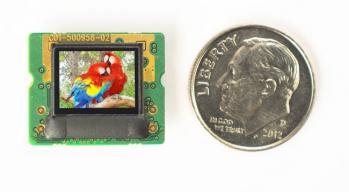 eMagin XGA096 OLED-XL
eMagin XGA096 OLED-XL
OLED microdisplays
OLED microdisplays are considered to be the current state-of-the-art near-eye display technology. OLEDs offer many advantages over competing technologies:
- No backlight - a direct emissive display with high contrast and a wide color gamut
- Fast refresh rate
- Low power consumption (this depends on the image shown)
- Wide operation temperature range
OLEDs do suffer from lower lifetime, limited market capacity, high price. Many believe that microLEDs will offer the ultimate solution for microdisplays, with their inherent high brightness and efficiency, but these displays are not commercial yet.
The OLED Microdisplay market
Several companies in the US, Europe and Asia are producing OLED microdisplays - including eMagin, Sony, OLiGHTEK, Kopin, BOE and SeeYa.
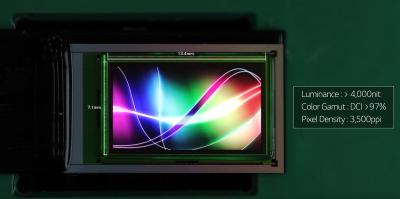
If you're interested in adopting OLED microdisplays in your device, we'll be happy to help, you can browse available display in our OLED marketplace. Be sure to send us a mail and together we can find the best display for your project.
OLED-Info's OLED and MicroLED Microdisplay Market Report
 If you want more in-depth information on the OLED (and MicroLED) Microdisplay market, look no further! Our OLED and MicroLED Microdisplay Market Report explains:
If you want more in-depth information on the OLED (and MicroLED) Microdisplay market, look no further! Our OLED and MicroLED Microdisplay Market Report explains:
- Why OLED microdisplays are better than LCD or DLP ones
- The disadvantages of OLED microdisplays
- What kind of displays are available on the market today
- New technologies on the horizon, including MicroLED microdisplays
The report package also provides a complete list of OLED and microLED microdisplay makers and developers, their current (and future) products, and personal contact details into the leading microdisplay makers. Read more here!
The latest OLED microdisplays news:
BCDTek completes the building construction of its upcoming K2 OLED microdisplay fab in Huainan
In 2022, OLED microdisplay developer BCDTEK announced its plans to construct a 12-inch OLED microdisplay production site in Huainan, China. The new fab, at full capacity, will have a production capacity of 20,000 monthly substrates, and a total investment of 6.5 billion Yuan ($970 million USD).
The first phase of this fab (the K2 line), is now in construction, and the company announced that the building itself is now complete. The total investment in the first phase, which will have a monthly capacity of 4,000 wafers, will cost 1.5 billion Yuan ($210 million USD).
Samsung : SDC to focus on OLED microdisplays while SSI will handle its Micro-LED development
In 2022, Samsung Display confirmed it is developing OLED microdisplays, and the company has since stepped up its efforts to bring OLED microdisplay to the market. The company is also developing microLED microdisplays.
It is now reported in Korea that Samsung Electronics decided that from now on, Samsung Display will handle all OLED microdisplay projects, while Samsung Semiconductor (SSI, or specifically, the Compound Semiconductor Solutions team) will handle all microLED microdisplay development.
IPValue buys 200 OLED patents from Seiko Epson
IPValue Management announced that it has acquired around 200 OLED patents from Seiko Epson. We do not know the nature of these patents, and whether IPValue bought all of Seiko Epson's OLED IP portfolio or just a part of it. IPValue says that the patents will be owned by its subsidiary Lumitek Display Technology.
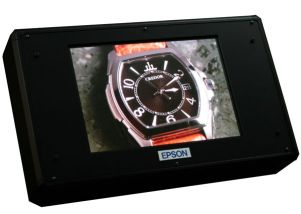
Seiko Epson has been working on OLED technologies for many years - and it has been involved mostly with soluble OLED materials, ink-jet printing and OLED microdisplays. In 2013 Samsung Display bought several OLED patents from Seiko Epson.
Updated: TrendForce says Apple chooses Seeya and BOE to supply its Vision Pro OLED microdisplays over Sony
Last week we posted the following article, but it turns out that our information was not correct. We mentioned that this was a strange report - and indeed it turns out that Trendforce analysis was misquoted, and the company did not say that Apple will stop using Sony's OLED microdisplays. We are sorry for posting this!
Apple first VR headset, the Apple Vision Pro, will use dual 1.3" 4K OLED microdisplays. Apple has been working with Sony, that produced the first OLED microdisplays, but later reports suggested that Apple is looking to replace Sony with Seeya and BOE as its suppliers to reduce costs (and also likely to increase potential supply as Sony has limited capacity).
According to a new report by TrendForce, Apple has made some changes to its Vision Pro supply chain and has decided to already stop using Sony's OLED microdisplays - and indeed go with Seeya and BOE.
Samsung to reportedly launch a high-end VR HMD powered by dual OLED microdisplays
According to reports, Samsung Electronics is working on a new VR headset that it plans to release in the second half of 2024.
The new headset will be based on OLED microdisplays, apparently produced by Samsung Display. The reports suggest the the microdisplays will be similar to the 1.41" 4K Sony OLED microdisplays used by Apple in its Vision Pro headset.
Russian citizens arrested in the US, claimed to have illegally bought OLED microdisplays for Russian customers
The New York State Attorney has arrested a Russian citizen called Maxim Marchenko, and two other co-conspirators, accusing them of buying $1.6 million worth of military-grade OLED microdisplays and smuggling these to Russia. The US export control laws forbid the sale of such components to Russian companies.
According to the prosecutors Marchenko hid the fact that these displays were going to Russia, and claimed that these will be used by Chinese companies for use in electron microscope for medical research. Marchenko was charged with seven criminal counts including wire fraud, smuggling, money laundering and four conspiracy counts.
Reports suggest LG Display decided to postpone its OLED microdisplay fab
LG Display has been developing OLED microdisplay technologies for several years (branding these as OLEDoS), and last year it was reported that LGD is planning to build its first production line, as hoping to supply OLED Microdisplay to Apple in the future. LG is reportedly started ordering deposition equipment from Korea-based OLED equipment maker Sunic System.
According to the Korean publication The Elec, LGD has decided not to build an OLED microdisplay production line, at least for now. The company will continue its R&D project, though.
The US Navy placed a $347 million order to replace the F-35 helmets, to adopt OLED microdisplays in the new design
According to reports, the U.S. Navy’s Naval Air Systems Command has placed a $347 million order with Lockheed Martin for a specialized helmet for pilots of the F-35 fighter jet. The new helmet, developed in collaboration between Collins Aerospace and Elbit Systems, will feature an OLED microdisplay, to replace the currently-used LCDs.

In 2018, we reported that the current F-35 Joint Strike Fighter helmet uses an LCD microdisplay (produced by Kopin), which suffers from a green glow (from the LED backlighting) that prevents pilots from seeing a carrier's lights at night. In addition, the current LCD display suffers from optical blooming - light that spills from lit pixels to their adjacent area. Following these issues, the US Navy started testing OLED microdisplays to replace the LCD.
Apple aims to adopt lower-cost OLED microdisplays at future Vision Pro products, in talks with BOE and Seeya
Apple first VR headset, the Apple Vision Pro, adopts dual 1.3" 4K OLED microdisplays made by Sony. According to reports, Apple is looking to replace Sony as its supplier and is testing displays made by Seeya and BOE. Apple seems to be aiming to adopt these in its next-gen Vision Pro model - and also in a future low-cost mixed-reality headset.
Sony officially launched its 1.3" 4K OLED displays last week, with an official price of $1,000 per unit. Some reports suggest that Apple is paying $350 per display - which is still very expensive, as the two OLED displays cost almost half of the total production cost of the Vision Pro (estimated at $1,500).
Sony officially launches its 1.3 4K OLED microdisplay product
Back in 2021, Sony unveiled a 4K OLED microdisplay prototype. In June Apple announced the Vision Pro headset, which uses two Sony-made 1.3" 4K (3,552 × 3,840) OLED microdisplay, made by Sony. And today Sony finally officially introduced its ECX344A display, targeting VR and AR devices.
Sony says that in order to develop the new display it developed new miniaturization processes as well as a new pixel drive circuits and a high-speed driver circuit. Sony says that the display will ship by the end of 2023 and its price is set at 150,000 Yen, or just over $1,000 USD (it is estimated that Apple pays around $350 for each panel).
Pagination
- Previous page
- Page 2
- Next page
